|
Holy Works of
Art
By Mike McLeod
Johannes Gutenberg, 15th
Century Marketing Guru. Not long ago, illuminated manuscript Bible
leaves commanded celestial prices at a Sotheby's auction. An
intricately illuminated opening leaf to a Giant Atlantic Bible
(Latin) manuscript on vellum from 12th century Tuscany (14" x 17")
brought $12,500. An illuminated Paris Bible leaf from the mid-13th
century on vellum (6.8" x 10.5") and made of two partial leaves
joined vertically sold for more than $3,500.
The artistry and beauty of
such pieces-to say nothing of their historical value-are superb, and
it is no wonder they fetch such wonderful prices. Meticulously
copied by hand, a complete Bible, unadorned, required three years'
of the undivided attention of a monk, scholar or scribe. After that,
the upper class person purchasing the Bible contracted with an
illuminator to draw pictures of foliage, biblical characters, or
graphic designs on designated pages. Starting letters of important
books were rubricated, and the text could also be bordered in red
using a straight edge, quill and red ink. All according to the taste
and whims of a wealthy client.
Because of the importance
of religion in everyday life, it is no wonder that Johannes
Gutenberg chose the Bible as the first book to be printed on his
moveable-type printing press. That and the fact that the market was
good for Bibles. Johannes was no 15th century marketing dummy. Like
Henry Ford and the assembly line, Gutenberg realized the income
potential of mass-producing Bibles.
In the three years it took
a monk to create just one Bible, Gutenberg printed 180, each with
1,828 pages. If only Gutenberg had also invented IPOs. (As with most
innovators, Gutenberg's financial status was precarious most of the
time. At one point, a creditor took him to court and he lost his
printing equipment and half the Bibles he'd printed. However, there
was a happy ending. The Bishop of Mainz recognized the importance of
Gutenberg's printing press and appointed him courtier. He also
granted Gutenberg 2,180 liters of grain and 2,000 liters of wine per
year, allowing him to live comfortably until his death in
1468.)
Another indicator of
Gutenberg's marketing savvy-in my opinion-was the fact that he
specifically manufactured his typeface to look like handwriting. Now
it's possible that Gutenberg just wasn't very creative graphically
and couldn't think of any of the hundreds of typefaces available
today. However, I believe he intentionally tried to create
manuscript Bible look-alikes, thinking they would sell better. (A
side note: the clarity and near perfection of the handwriting in
manuscript Bibles look as if they were typeset, which made it easier
for Gutenberg to copy.)
Today if one of the few
Gutenberg Bibles came to market, it would easily sell for $30
million dollars or more, according to John Jeffcoat III, marketing
director of www.greatsite.com, an Internet seller of rare bibles.
"The last time a Gutenberg Old Testament fragment (not even
complete) sold, it commanded over $16 million." At this writing,
Greatsite.com is offering a leaf from a Gutenberg Bible for
$65,000.
Gutenberg the marketing
guru would be very happy.
Word of God, Work
of Art
Although acquiring a
Gutenberg Bible or a leaf is out of the range of many collectors,
early bibles and individual leaves are not.
"You can pick up a
400-year-old page for the cost of taking your family out to a
movie," said Mel Meadows, a collector and a vendor on the Ruby Lane
website. At this writing, Mel was offering a 1602 small folio (see
sidebar, "Bible Definitions") Geneva Bible leaf for sale for $14 and
"starter sets" for new collectors with 22 leaves from 22 bibles from
1581 to the late 1700s for $175.
These are not first edition
leaves, but they are historically important and very old by American
standards. Leaf collecting is an affordable hobby for beginners with
unexpected advantages. Some of the text-block pages offered by Mel
Meadows are ruled in red from the quill of a paid scribe.
For collectors, printed
bibles offer a world of categories and possibilities: bibles printed
in America; Indian language bibles; bibles printed in Europe, and
foreign language bibles, such as Asian languages, Russian/Slovak,
African dialects, etc.
Of the bibles printed in
Europe, most were printed in England, which is a benefit to
collectors because people tend to want books they can
read.
The dates bibles are
printed are crucial to their collectibility and value. For bibles
printed in England, pre-1650 is the key date. In this category, a
few are: the Geneva Bible, King James Version (KJV), Tyndale Bible,
Giant Bible, Bishop's Bible, Matthews Bible, Rheims New Testament
Bible, and more. For bibles printed in America, the 1700s are the
dividing line.
Why is the year 1650
critical to collecting bibles printed in Europe? According to John
Jeffcoat, the KJV stayed pretty much in its original form until
then. (The KJV purchased today lists the date of 1611 on its title
page, but in reality, it was revised in 1769.)
Greatsite.com offers Geneva
Bible and King James Version leaves starting at $39. Why so cheap
for parts of documents that are older than the
Constitution?
"Pre-1650 KJV leaves are
not rare," said John Jeffcoat. "They are almost a novelty item. But
first edition 1611 KJV leaves are rare and are worth between $300
and $600 each."
Complete pre-1650 bibles
are rare. A complete first edition 1611 KJV is valued at $100,000 to
$300,000. But prices drop radically after that, and non-first
edition KJVs printed after 1611 and before 1650 can be found for
sale between $2,000 and $5,000, depending on the size and condition
of the text.
Understandably, more
partial Bibles have survived the centuries than complete ones. A
book seller who buys a partial bible has a couple of uses for
it-either it can be sold as individual leaves, or parts of it can be
tipped in to repair and complete another partial bible. Mixing and
matching parts of bibles may seem almost sacrilegious to new
collectors. But for antiquarian sellers, the practice is
SOP.
With the KJV, the Geneva
Bible and others, only the title pages were changed from year to
year. The text itself remained the same, so pages or sections can be
tipped in that were printed on the same press by the same person in
the same year.
Title pages are also very
valuable, running into the hundreds or the thousands of dollars. Mel
Meadows has noticed a distinct lack of title pages to the 1611 KJV.
"Someone started collecting them a long time ago."
Part of the
allure of collecting early Bibles is knowing the history and the
sacrifice surrounding these wonderful books. Prior to the KJV, the
clergy and royalty fought to keep English translations out of the
hands of the common people. Scholars were put to death-often by
burning at the stake-for publishing the Bible.
The Geneva Bible was an
extremely popular English-language Bible. It was translated and
printed in Geneva, Switzerland, in 1560. After Mary Tudor came to
the English throne in 1553, she sought to restore Catholicism as the
national religion. Christian scholars were persecuted and killed, so
many ran for their lives to other parts of Europe. Geneva welcomed
many of these scholars, and it was here the Geneva Bible was
created.
The Pilgrims carried the
Geneva to America, and William Shakespeare quoted from it often in
his plays. For 100 years and through 144 printings, it was the
principle Bible used by Christians.
A complete first edition
Geneva can sell for $16,000 or more.
A few key factors in
valuing older bibles-first, shaving. This is where worn edges of
pages have been cut off, and it can reduce the value of a bible by
80% to 90%, according to Jeffcoat. Look for the headline at the top
of the page. The headline is a sentence that describes the scripture
story on that page. If a headline is missing, or if you can only see
the bottom of the letters, the page has been shaved.
Second, missing pages. A
few missing pages from older Bibles are not critical. They can
usually be matched and tipped in by a professional. However, a whole
book or section missing is a problem that is very difficult if not
impossible to fix.
Third, binding. "You can
expect Bibles hundreds of years old to have ratty binding," says
Jeffcoat. "You can't expect leather to keep from turning to dust,
but it only affects the price by a few hundred dollars. Binding can
be replaced. However if the original binding hasn't turned to dust,
it commands a premium price."
It is the text block that
is important, not the binding.
For Bibles printed in
America, those from the 1700s command the highest values. Bibles
from the 1800s can be found on the Internet and in shops for as
little as $25. Although they may be priceless family heirlooms, the
experienced collector knows they were printed in mass quantities,
compared to the 5,000 or 6,000 print run of a bible in the 1700s. In
addition, 1800s bibles are not first or second edition bibles, and
they are printed on wood pulp paper, which degrades relatively
quickly.
The early bibles were
printed on rag paper or vellum. Before the discovery of wood pulp
(which required the use of acid to make it into paper), paper was
made from many materials-papyrus, cotton linen, plant fiber,
parchment, vellum and cloth rags.
Before Gutenberg in the
15th century, vellum was the paper material of choice. Made from
animal skin, it was expensive, but it was also very durable.
Pre-pulp paper books are acid-free, so they last. According to Mel
Meadows, "At the estate sales overseas, you find three-quarters of
the early Bibles in great shape because they were printed on
pre-acid paper."
The investment-quality
American Bibles were published between 1782 and 1798. The first
English language Bible printed here was in 1782 by Robert Aitken.
Although small (3" x 5") and ugly (plain, cheap pocket edition with
no illustrations), one example has sold for $95,000. The reason for
it high value is the Aitken Bible holds the distinction of being the
only Bible authorized by Congress-the Continental Congress, that is.
It was commissioned as a statement against the Crown during the
Revolution, pointedly declaring that the Colonists would print their
own Bible in America, despite British orders otherwise.
In 1791, Isaac Collins, a
Quaker, printed the first Family Bible. Because the Aitken Bible was
so small, families couldn't gather around and read it together.
Isaac Collins' Bible rectified this by increasing its size to 8" x
10". It is not a fancy bible, probably owing to Collins' Quaker
roots, but it is heralded as a perfect bible. The spelling and
accuracy is flawless. There are only two typographical errors, and
those are broken punctuation marks. Collins had his children
proofread his Bible eleven times before it was printed. The Family
Bible was used as a pattern for other Bibles for 110
years.
Other valuable bibles
include Isaiah Thomas' illustrated Bible, the 1798 Thompson Hot
Press Bible (ink and type were heated and seared into the page), and
the 1663 first edition Algonquin Bible, which sold for $400,000.
As always, there are exceptions to the rule about valuable
bibles and their publishing dates:
- The Jane Aitken Bible in
1800-the daughter of Robert Aitken, this was the first Bible
printed in America by a woman.
- The 1833 Noah Webster
Bible-it was the first revision of the KJV in America. Its sales
bombed, but Noah's dictionary made him rich.
- The 1841 Hexapala
Bible-very valuable; it displays the scriptures in Greek
positioned next to six other famous translations.
- The 1843-1846 Harper
Brothers Illuminated Bible-a KJV that is lavishly
illustrated.
The Bible has been printed
in several Indian languages, including Cree, Sioux, Mohawk, Navajo
and Algonquin. Collectors enjoy picking them up, but other than the
original Algonquin, they are not investment grade. In addition,
bibles in Asian, Slavic, and African languages do not sell well or
increase in value.
Many collect the Bible
because it is sacred, others for the physical beauty of the page or
for its historical importance. But whatever the reason, the Bible
has had great appeal for the past 400 years or so.
2001
|
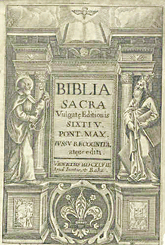
1648 title
page, Vulgate edition, with exquisite illustrations. (Courtesy Mel
Meadows)
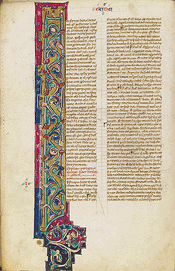
Manuscript
Bibles required three years of work to create. Then an artist
illuminated specific pages to make the Bible unique.
(Courtesy
Sotheby's)
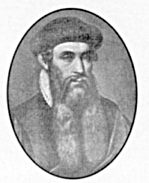
Johannes
Gutenberg
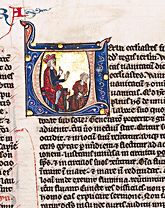
Illuminated
manuscript Paris Bible leaf from mid-13th century, $3,500. (Courtesy
Sotheby's)

Egyptian Book
of the Dead, papyrus. Papyrus was used as paper by the Egyptians
from 5000 B.C. until the 9th century A.D.
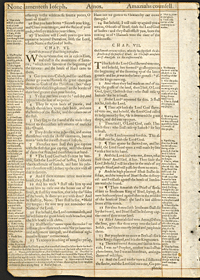
Geneva Bible
leaf, 1583, ruled in red, $14-$39.
(Courtesy Mel
Meadows)
![]()
1647 title
page, Latin.
(Courtesy Mel Meadows)
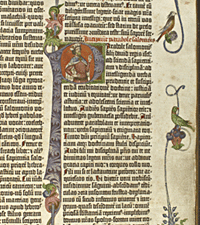
Gutenberg
Bible, King's copy with inset drawing of Solomon. (By permission of
The British Library, Kings Library Copy Vol 2 (Solomon) C.9.d.3, 4=1
C.55)
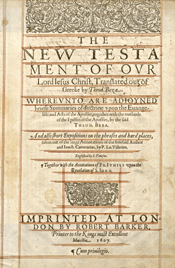
1607 Geneva
Bible title leaf ruled in red. Notice the hyphenation.
(Courtesy
Mel Meadows)
|
BIBLE DEFINITIONS: |
Folio: a large size Bible, 14 inches
in length or larger. A large sheet of paper is printed with
two pages of text on the front and the back and then folded
before collating and binding. Folios are also known as
"pulpit" Bibles because the large size made them easier to
read while preaching from the
pulpit.
Illumination: the decoration of a
Bible after printing with colored foliage or other pictures by
artists, or illuminators, contracted by the Bible's
owner.
Incunabula: books published between
1455 and 1499, roughly 50 years after Gutenberg's first
printing.
Parchment: paper made from the
skin of a sheep or goat.
Quarto: the size of a Bible,
usually 6 1/2 to 7 inches by 8 1/2 to 9 inches.
Rag
Paper: Paper made from cotton or linen. Plant fibers
were first used to make paper. After Gutenberg, books
proliferated and the need for paper skyrocketed. Vellum was
developed, but was very expensive. Early Europeans made paper
from recycled cotton and linen which created a great demand
for rags, thus the term "rag paper." The demand for paper even
outgrew rags, and experiments were made with straw, cabbage,
Egyptian mummies and wasps' nests before wood pulp was
discovered.
Rubric (or rubrication): A
part of a manuscript or book, such as a title, heading, or
initial letter, that appears in decorative red lettering or is
otherwise distinguished from the rest of the text.
Octavo: a pocket-sized
Bible.
Shaving: cutting off the worn edge
of pages, greatly reducing the value, by up to 80% to
90%.
Vellum: a fine paper made from
untanned animal leather (calf, lamb, or kid), scraped and then
smoothed with pumice stone. Also used for binding books. It
required the skins of 250-300 sheep to make enough vellum for
one manuscript Bible.
| |